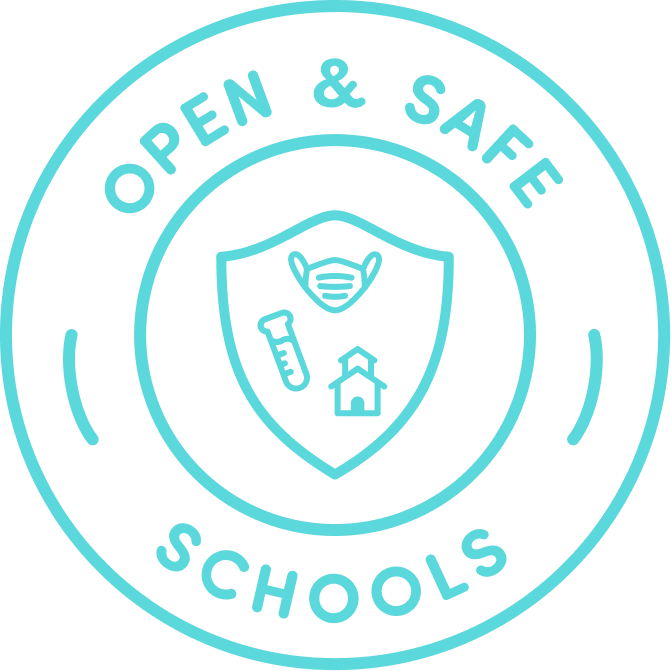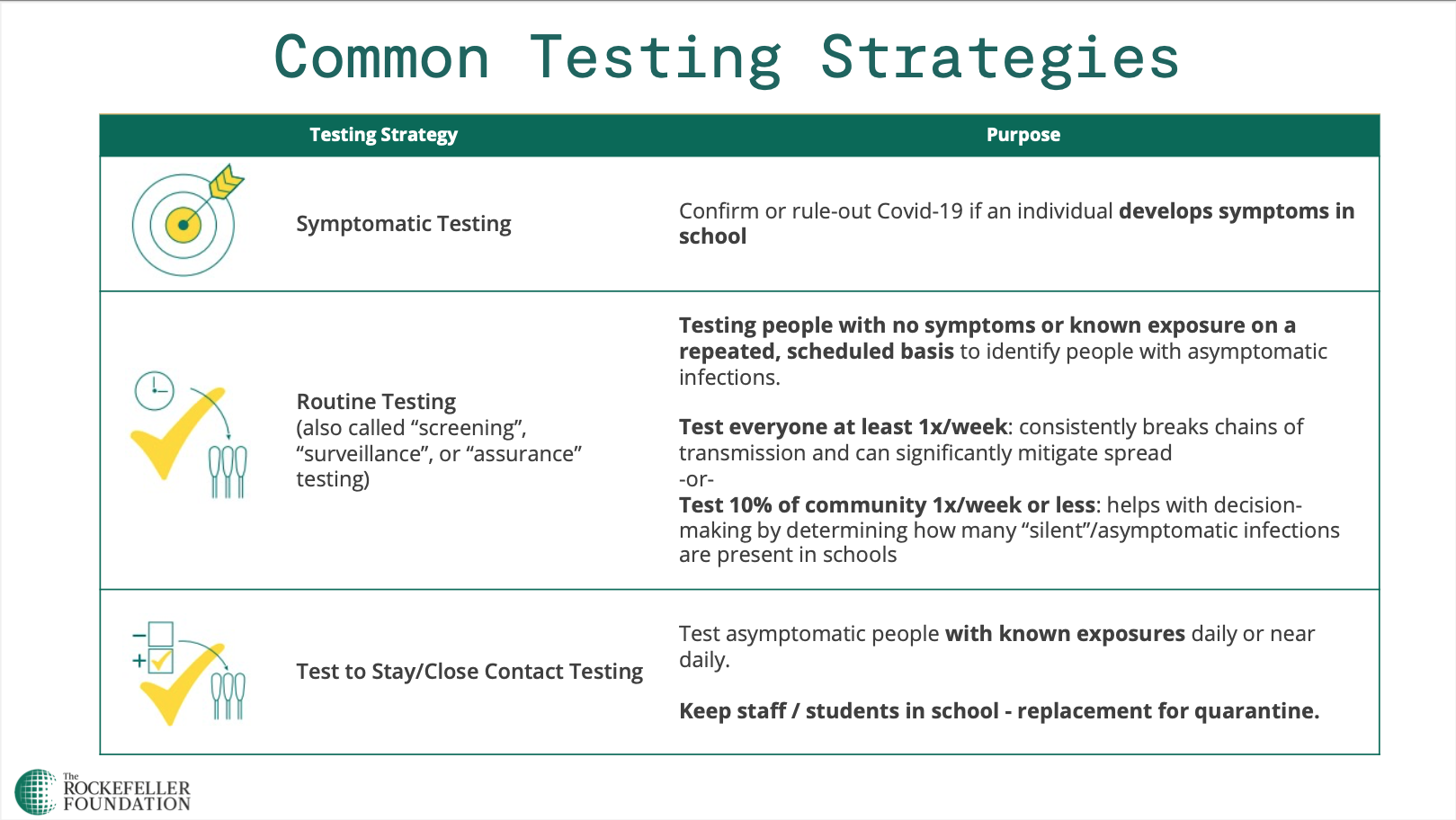Why to Test
Click to jump to details about…
School COVID-19 Testing In Action
How Testing Helps Schools Safely Reopen for In-Person Learning
Key Terms and Numbers
Top 3 Reasons to Implement School COVID-19 Testing
Testing is Part of Broader Prevention Strategies
More Resources
School COVID-19 Testing In Action
Regular (e.g., weekly) testing of your entire population or a portion of your population
School testing programs help detect positive cases before they become outbreaks and enable institutions to stay open with confidence
Testing programs also help school leaders understand if prevention efforts are working or if other measures need to be taken to protect the school community
Click the above image to download a shareable copy
School COVID-19 Testing in Action
The Eliot School, Boston, MA Public Schools, Testing by CIC
Sahuarita Unified School District, AZ, testing by eTrueNorth
Top 3 Reasons to Implement
School COVID-19 Testing
School COVID-19 Testing Programs…
… help prevent in-school transmission. School COVID-19 testing programs reliably catch asymptomatic or presymptomatic cases of COVID that otherwise might have gone unnoticed. By isolating those individuals before they have a chance to infect others, school COVID-19 testing programs reduce school closures and enable more sustainable in-person learning.
School COVID-19 Testing Programs…
… help prevent COVID-19 spread in school
School COVID-19 testing programs reliably catch cases in those without symptoms that otherwise might have gone unnoticed. By isolating those individuals before they have a chance to infect others, school COVID-19 testing programs reduce school closures and enable more sustainable in-person learning.
“Weekly testing of all students, teachers, and staff can reduce in-school infections by an estimated 50 percent”
… build confidence among families and staff that returning to school is safe.
Many schools have opened with far less than full attendance, school screening programs can help reassure nervous families that schools are in fact safe places to learn.
Source: Wellesley Public Schools
… protect the broader community
By increasing the testing resources in the community, school COVID-19 testing programs enable students and families to protect their family, friends, and community and provide more information for local public health leaders to continue fighting the virus.
“Nearly half of all SARS-CoV-2 infections are transmitted by people who are not showing any symptoms…A positive test early in the course of the illness enables individuals to isolate themselves – reducing the chances that they will infect others and allowing them to seek treatment earlier, likely reducing disease severity and the risk of long-term disability, or death.”
How Testing Helps Schools Safely Reopen for In Person Learning
Consistent, broad-based COVID-19 testing is a solution we can deploy right now, along with standard precautions like masking, distancing, and hand washing, to keep our students and staff safe.
Given the disease trajectory and the fact that we currently do not know when vaccines will be available for children under age 12, safely and sustainably reopening schools may require school COVID-19 testing programs both this year and next.
According to the CDC’s Operational Strategy for K-12 Schools, testing should part of a comprehensive approach to safely reopen schools. Regular screening for COVID-19 is recommended for teachers and staff in all schools and for all students in areas of moderate, substantial or high transmission. Fully vaccinated individuals (2 weeks after the final dose) can be exempted from regular screening programs.
CDC Recommendations on School COVID-19 Testing Programs by Level of Community Transmission
The goal of regular COVID-19 testing in schools is to quickly identify cases before they become outbreaks. When used alongside other prevention strategies, like distancing and face masks, testing creates an additional level of reassurance that it is safe to keep schools open with students and educators in the classroom in person
“Pooled testing is one of the many mitigation strategies that the district has implemented to help prevent the spread of COVID within our school community. The pooled testing program is an added layer that has given our families and staff increased peace of mind and confidence in the safety of our buildings and school community. The program also allows us to identify asymptomatic students and to quickly identify positive cases, quarantine them and contact trace to prevent further spread of COVID-19 in the school community.”
School COVID-19 Testing is Part of Broader Prevention Strategies
Routine screening does not replace other prevention measures, such as social distancing and face masks. For detailed recommendations on prevention strategies, please see CDC’s Operational Strategy for K-12 Schools.
The Swiss Cheese Model shows how COVID testing is another layer of support that helps limit transmission in schools even further.
Source: CIC Health
Promoting health safety is similar to promoting fire safety.
Source: www.whentotest.org
Key Terms and Numbers
This is new for everyone, and getting our terminology right when we talk about testing programs is key to keeping everyone on the same page.
First and foremost, there are many different types of of COVID-19 tests. Learn about the different types below.
Click the image to download a shareable copy
More Key Terms
Prevalence Rate: This is the rate of disease in the community (usually counted over either the last 7 days or the last 14 days) divided by the total population of the community. We assume this is underestimated in many cases because of individuals who may be infected and either not know it or choose not to get tested.
Test Positivity Rate: This is the percent of COVID-19 tests that are taken that come back positive. Because most people get tested when they have symptoms or come in contact with a COVID-19 positive individual, community test positivity rate is generally much higher than community prevalence.
Screening Testing: Screening testing is what we’re doing in schools - testing an entire group whether or not they have symptoms with the goal of identifying and isolating COVID-19 positive individuals.
Helpful Numbers
A sample of school districts that tested throughout Winter 2020-2021 allow us to see that school test positivity rates are generally lower than community prevalence rates and significantly lower than test positivity rates. Note that school COVID-19 testing programs test positivity rates are low in part because these programs actively screen out symptomatic individuals. Symptomatic individuals are asked to stay home and get tested outside of the school.
Source: Selected School Screening Vendors
More Resources on School COVID-19 Testing
OpenAndSafeSchools.org contains resources for school leaders, including information on federal programs to support school testing and a toolkit to help launch school COVID-19 testing programs.
The K-12 National Testing Action Program: Connecting Schools with the Nation’s Leading Testing Companies to Safely Reopen, from the Rockefeller Foundation and Health Catalysts Group
CovidEdTesting.com is a toolkit to support the Massachusetts Pooled Testing Program.
Covid-19 Testing in K-12 Settings: A Playbook for Educators and Leaders from the Rockefeller Foundation.
Consolidated Tabletop Resources for Implementation of COVID-19 Testing in K-12 Settings from Chiefs for Change.
COVID-19 Testing in K-12 Settings: “Day in the life of” (DILO) case study examples from Chiefs for Change.
RADx K-12 Playbook and Testing Impact Calculator: whentotest.org/k-12
COVIDCheck Colorado Example Protocol for School Based Saliva Testing.






